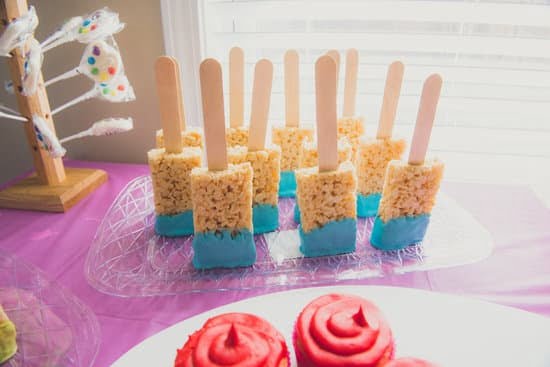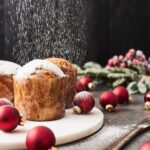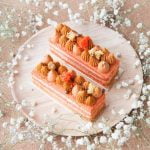Cake Decorating Ruffle is an art that has captivated cake enthusiasts and professionals alike. This intricate technique adds a touch of elegance and sophistication to any cake design, making it a popular choice for special occasions and celebrations. In this article, we will delve into the world of Cake Decorating Ruffle, exploring its significance in the realm of cake decoration and offering insights into its historical evolution.
Cake Decorating Ruffle involves creating delicate frills and waves on the surface of a cake, resembling fabric ruffles. It adds texture and dimension to cakes, elevating them from ordinary confections to breathtaking works of art. This technique has been embraced by bakers throughout history, with various methods developed over time to achieve stunning ruffle designs.
Understanding the different types of Cake Decorating Ruffle techniques is essential for mastering this art form. In this article, we will explore step-by-step instructions and provide visual examples for each technique. From pleats to frills to cascading ruffles, we will guide you through the process, enabling you to create professional-looking ruffles that are sure to wow your friends and family.
Join us as we embark on a journey through the enchanting world of Cake Decorating Ruffle.
Discover the tools and materials required for achieving flawless ruffles, explore popular ruffle designs that can be applied to various themes and occasions, master the art of color selection for harmonious designs, troubleshoot common issues that may arise during the decorating process, learn how to combine ruffles with other decoration techniques, and uncover tips for taking your Cake Decorating Ruffle skills to the next level.
Unleash your creativity and let your imagination soar as you incorporate this beautiful technique into your next cake decorating project.
Understanding Different Types of Cake Decorating Ruffle Techniques
Cake Decorating Ruffle Techniques: An In-depth Look at Various Methods
When it comes to cake decorating, ruffle designs offer a beautiful and elegant touch that can elevate any cake. There are various techniques for achieving stunning ruffle designs, each with its own unique method and style. In this section, we will explore some of the most popular cake decorating ruffle techniques, providing step-by-step instructions and visual examples for each one.
Petal Ruffles
One of the most common and versatile ruffle techniques is the petal ruffle. This technique creates delicate layers that resemble flower petals. To achieve this look, start by rolling out a thin strip of fondant or gum paste. Next, use a ball tool or your fingers to thin and soften the edges of the strip.
Gently fold the strip in half and attach one end to your cake using a small amount of edible glue or water. Then, begin pleating and gathering the strip along its length, attaching it to your cake as you go. Repeat this process with additional strips until you achieve your desired ruffle effect.
Frill Ruffles
Frill ruffles are another popular technique that adds texture and movement to a cake design. To create frill ruffles, start by rolling out a thin strip of fondant or gum paste. Using a frill cutter or a sharp knife, make small incisions along one edge of the strip at regular intervals.
Gently lift and pull on each incision to create frills that extend outward from the strip. Attach one end of the frilled strip to your cake using edible glue or water, then continue attaching more frilled strips in overlapping layers until you achieve the desired volume and effect.
Ribbon Ruffles
Ribbon ruffles offer a more structured and geometric look compared to other ruffle techniques. To create ribbon ruffles, roll out a strip of fondant or gum paste and cut it into thin, straight pieces. Next, attach one end of each ribbon to your cake using edible glue or water and fold the other end inwards to create pleats.
Arrange the ribbons in overlapping layers, alternating the direction of each layer to achieve a visually interesting pattern. Continue attaching more ribbons until you achieve your desired ruffle design.
By understanding these different types of ruffle techniques, you can experiment with various styles and create unique designs that suit your cake decoration needs. Whether you opt for delicate petal ruffles, textured frill ruffles, or structured ribbon ruffles, mastering these techniques will allow you to add a touch of elegance to any cake creation.
Choosing the Right Tools and Materials for Cake Decorating Ruffle
Essential Tools and Equipment
When it comes to creating stunning ruffle designs on cakes, having the right tools and equipment is essential. To achieve professional-looking results, there are a few key items that every cake decorator should have in their arsenal.
One of the most important tools for creating cake decorating ruffles is a set of offset spatulas. These spatulas come in various sizes and are designed to help smooth buttercream or frosting onto the cake, as well as create clean and precise ruffle patterns. A small offset spatula is perfect for smaller ruffles, while a larger one is ideal for bigger designs.
Another must-have tool for cake decorating ruffles is a fondant smoother. This tool helps to even out the fondant surface and ensure that the ruffles are flat and uniform. Additionally, a ball tool can be useful for creating realistic texture on fondant ruffles.
High-Quality Materials
In addition to having the right tools, using high-quality materials is crucial for achieving professional-looking ruffle designs. When it comes to fondant, opting for a premium brand can make a significant difference in the final result. High-quality fondant will be pliable and easier to work with, allowing you to create smooth and flawless ruffles.
When choosing buttercream or frosting for your cakes, it is important to select one that has good consistency for creating ruffles. A light consistency buttercream works best as it allows you to pipe delicate and elegant ruffles without any difficulties.
Lastly, selecting food coloring that is vibrant and true-to-color will enhance the overall appearance of your cake decorating ruffle design. It’s also important to choose colors that complement each other and match the theme or occasion of the cake.
By investing in high-quality tools and materials, you’ll be setting yourself up for success when it comes to creating beautiful cake decorating ruffle designs.
Exploring Popular Cake Decorating Ruffle Designs
Cake decorating ruffle designs have become incredibly popular in recent years, adding a touch of elegance and visual interest to cakes for various occasions. In this section, we will showcase a collection of eye-catching ruffle design inspirations that are sure to impress. From delicate and romantic frills to bold and modern waves, there are endless possibilities when it comes to incorporating ruffles into your cake decorations.
One popular ruffle design is the cascading ruffle technique, where layers of fondant or buttercream are arranged in a cascading fashion around the cake tiers. This creates a beautiful waterfall effect that is perfect for weddings and other formal events. It is important to ensure that each layer is evenly spaced and secured with edible glue or water to prevent them from collapsing.
Another stunning ruffle design is the ombre ruffle technique. This involves using different shades of the same color to create a gradient effect on the cake. Start with the darkest shade at the bottom and gradually lighten the shade as you move upwards. The result is a visually striking cake that adds depth and dimension to your dessert table.
For those who prefer more intricate designs, consider trying the pleated ruffle technique. This involves folding strips of fondant or gum paste at regular intervals to create pleats. The pleats can be attached horizontally or vertically on the cake surface, creating an interesting texture that catches the eye.
Incorporating ruffles into your cake decorating repertoire allows you to unleash your creativity and experiment with different styles and combinations. Whether you opt for soft and feminine frills or bold and structured waves, ruffles are sure to add a touch of sophistication to any cake design.
| Ruffle Design | Description |
|---|---|
| Cascading Ruffles | Layers of fondant or buttercream arranged in a cascading fashion for a waterfall effect |
| Ombre Ruffles | Different shades of the same color creating a gradient effect on the cake |
| Pleated Ruffles | Folded strips of fondant or gum paste creating pleats for an interesting texture |
Mastering the Art of Color Selection for Cake Decorating Ruffle
Color selection is a crucial aspect of cake decorating ruffle designs, as it can greatly impact the overall visual appeal and theme of the cake. When choosing colors for ruffles, it is important to consider the occasion, the desired mood or atmosphere, and how the colors will harmonize with other design elements on the cake. Here are some tips and tricks for mastering the art of color selection for cake decorating ruffles:
- Consider the overall theme: Start by understanding the theme or concept of the cake. Whether it’s a wedding, birthday, or any other special occasion, choose colors that align with the theme. For example, soft pastels like blush pink, mint green, and baby blue would be ideal for a romantic wedding cake, while bright and vibrant colors like red, yellow, and orange can create a festive look for a birthday celebration.
- Create contrast: To make your ruffle designs stand out, consider using contrasting colors. This can be achieved by selecting complementary colors from opposite sides of the color wheel. For instance, pairing red ruffles with green accents creates a visually striking combination due to their complementary nature.
- Experiment with shades and tones: Don’t limit yourself to just one color; instead, try playing with different shades and tones within a color family. Lighter shades create an airy and delicate effect, while deeper tones add richness and depth to the design. Graduating from lighter to darker shades of the same color can also create an ombre effect in your ruffles.
- Consider the cake’s environment: Think about where the cake will be displayed and how the surrounding environment might impact the colors. If the cake will be placed in a brightly lit room, you may want to choose colors that are more vibrant and bold to ensure they stand out. On the other hand, if the cake will be in a dimly lit venue, opting for lighter or pastel colors can help maintain visibility.
- Test your color combinations: Before committing to a specific color palette, it can be helpful to create small samples or swatches of different color combinations. This allows you to see how they look together and make any necessary adjustments before applying them to the cake.
| Color Combination | Description |
|---|---|
| Pastel Pink & Mint Green | A romantic combination perfect for weddings. |
| Navy Blue & Gold | A sophisticated pairing suitable for formal events. |
| Purple & Yellow | A vibrant and contrasting combination. |
Remember, selecting colors for ruffles is an opportunity to showcase your creativity and personal style. Don’t be afraid to experiment with different combinations and trust your instincts. By mastering the art of color selection, you can elevate your cake decorating ruffle designs and create truly stunning visual creations that leave a lasting impression on everyone who sees them.
Troubleshooting Common Issues in Cake Decorating Ruffles
Cake decorating ruffles can add an elegant and intricate touch to any cake, but they can also come with their fair share of challenges. In this section, we will explore some common issues that may arise during the cake decorating process and provide solutions to help you troubleshoot these problems.
- Uneven Ruffles: One of the most common issues when creating cake decorating ruffles is achieving a consistent and even look. Uneven ruffles can occur due to variations in pressure or speed while piping or applying fondant. To solve this problem, make sure to practice your technique beforehand and apply consistent pressure while creating the ruffles. Additionally, using an icing smoother or a fondant smoothing tool can help you achieve a more even finish.
- Fraying Fondant: When working with fondant for ruffle designs, it is not uncommon for the edges of the fondant strips to fray or become jagged. This can result in a messy and unprofessional-looking finish.
To prevent fraying, try using a sharp knife or pizza cutter to cut clean edges on your fondant strips before applying them to the cake. You can also lightly dust your work surface with cornstarch or powdered sugar to reduce stickiness and minimize fraying. - Maintaining Consistency in Design: Another challenge that decorators often face when creating ruffle designs is maintaining consistency in the size and shape of the ruffles throughout the cake. To ensure consistency, it is helpful to mark guidelines on your cake surface before piping or applying fondant. These guidelines can serve as reference points to help you keep your ruffles evenly spaced and uniform in size.
By addressing these common issues and implementing the recommended solutions, you can overcome these challenges and achieve stunning results with your cake decorating ruffles. Remember to practice patience and take your time when working on intricate designs, as mastering this art form takes practice. With perseverance and creativity, you will be able to troubleshoot any issues that may arise and create beautiful ruffle designs that will impress your clients and guests.
Incorporating Cake Decorating Ruffle with other Cake Decoration Techniques
Cake decorating ruffles are a versatile and beautiful technique that can add a touch of elegance to any cake. However, they don’t have to be limited to being standalone decorations. In fact, incorporating cake decorating ruffles with other cake decoration techniques can take your cakes to the next level and create unique and visually stunning designs.
One way to incorporate ruffles with other cake decoration techniques is by combining them with piping. Piping is a popular technique that involves using a piping bag and different tips to create intricate designs on the cake’s surface. By strategically placing ruffles alongside piped details, you can create a dynamic visual contrast that adds texture and depth to your cake design.
Another way to combine ruffles with other decoration techniques is by integrating them with fondant flowers. Fondant flowers are delicate and lifelike additions to any cake design, and when paired with ruffles, they create a harmonious balance between softness and structure. For example, you can layer fondant flowers on top of ruffled tiers or place small flower accents in between the ruffles for a cohesive and eye-catching look.
Edible painting is another popular decoration technique that pairs well with cake decorating ruffles. By using edible paint or food coloring gel, you can paint intricate designs directly onto the ruffled surface of the cake. This combination allows for endless possibilities in terms of color combinations, patterns, and overall aesthetics. Whether it’s adding delicate brushstrokes on each individual ruffle or creating larger painted scenes intertwined with the ruffles, this combination creates an artistic masterpiece.
Incorporating cake decorating ruffle with other cake decoration techniques opens up a world of creativity and possibilities for experienced decorators. By combining different textures, colors, and visual elements, you can create cakes that are truly unique and breathtaking. Don’t be afraid to experiment and push the boundaries of your skills to create one-of-a-kind designs that will leave a lasting impression on anyone who sees and tastes your creations.
Tips for Taking Cake Decorating Ruffle to the Next Level
Cake decorating ruffle is a beautiful and versatile technique that adds elegance and texture to any cake design. For those who have mastered the basic ruffle techniques and want to take their cake decorating skills to the next level, there are several advanced tips and strategies to consider.
- Experiment with Different Ruffle Sizes: While traditional ruffles are often delicate and small in size, don’t be afraid to experiment with larger ruffles for a bold and dramatic effect. Try creating oversized ruffles on the bottom tier of a cake or incorporating them as accents on specific areas of the design. Mixing different sizes of ruffles can also create visually interesting patterns and textures.
- Incorporate Alternative Materials: Expand your options beyond fondant by experimenting with alternative materials for creating ruffles. For example, try using wafer paper or edible fabrics to achieve unique textures and finishes. Each material has its own characteristics that can add depth and dimension to your cake designs.
- Add Embellishments: Take your ruffle designs to the next level by incorporating additional embellishments such as edible pearls, sequins, or even hand-painted details. These extra touches can elevate your cake design from beautiful to extraordinary. Consider adding small fondant flowers along the edges of the ruffles or using gold leaf to highlight certain areas.
- Play with Color Contrasts: Instead of sticking with traditional monochromatic or complementary color schemes, consider experimenting with contrasting colors for your ruffle designs. A vibrant-colored ruffled border against a neutral-hued background can create a stunning visual impact.
- Explore Advanced Techniques: Once you have mastered the basics, challenge yourself by exploring more advanced techniques such as pleating or layering different types of ruffles together. Pleated ruffles create intricate folds that add sophistication to your design, while layered ruffles provide dimension and depth.
By implementing these tips and pushing the boundaries of your creativity, you can take your cake decorating ruffle to the next level. Remember to practice and experiment with different techniques and materials to create truly unique and stunning cake designs. Let your imagination run wild and transform ordinary cakes into works of art with the power of ruffles.
Conclusion
In conclusion, the art of cake decorating ruffle offers endless possibilities for creativity and expression. Throughout this article, we have explored the various techniques, tools, and materials involved in achieving stunning ruffle designs on cakes. From understanding different types of ruffle techniques to troubleshooting common issues, this comprehensive guide has provided valuable information for both beginners and experienced cake decorators.
One of the key takeaways from this article is the importance of color selection in creating visually appealing ruffle patterns. By carefully choosing a color palette that harmonizes with the overall cake theme, decorators can elevate their designs to new heights. The tips and tricks shared in this article offer guidance on how to experiment with different color combinations to achieve striking effects.
Furthermore, this article highlighted how ruffles can be seamlessly integrated with other popular cake decoration techniques such as piping, fondant flowers, and edible painting. By combining these elements, decorators can create truly unique and breathtaking designs that will impress clients or loved ones.
Frequently Asked Questions
How do you decorate a cake with ruffles?
Decorating a cake with ruffles involves creating beautiful, delicate frills around the edges of the cake. To achieve this look, you will need to start by preparing your desired frosting or buttercream and coloring it if desired. Once the frosting is ready, fill a piping bag fitted with a petal tip or a leaf tip. Begin by piping a small dot or line at the bottom edge of the cake, slightly overlapping onto the side.
Then, using steady pressure, pipe another row just above the first one, allowing the frosting to create soft waves or frills as you move along. Continue piping rows of overlapping dots or lines until you reach the top of the cake. The result will be an elegant ruffled texture that adds a touch of sophistication to your cake.
How to make a ruffle around a cake?
Creating a ruffle around a cake involves careful piping techniques and attention to detail. Start by preparing your chosen frosting or buttercream and coloring it if desired. Fill a piping bag fitted with a petal tip or a leaf tip and hold it at approximately a 45-degree angle towards the surface of the cake.
Start on one side of the cake and gently apply pressure while moving your hand back and forth in short motions to create small frills that follow along the edge of the cake. As you move along, continue applying pressure while maintaining an even rhythm to ensure consistent ruffles around the entire circumference of the cake. Once you have made it all around, carefully finish by connecting the final ruffle to where you started for a seamless look.
What piping tip do I use for ruffles?
When it comes to creating ruffles on cakes using piping tips, there are several options available depending on your desired effect. One popular choice is using either petal tips (such as Wilton #104) or leaf tips (such as Wilton #67). These tips are designed with slightly curved edges that allow for easy creation of beautiful ruffles when used correctly.
Petal tips typically produce softer, more delicate ruffles, while leaf tips create sharper and larger frills. You can experiment with different sizes and shapes of these tips to achieve the desired look for your cake decoration. Remember to practice beforehand to get comfortable with the pressure, angle, and motion needed to create perfect ruffles using your chosen piping tip.

Welcome to our cake decorating blog! My name is Destiny Flores, and I am the proud owner of a cake decorating business named Cake Karma. Our mission is to provide delicious, beautiful cakes for all occasions. We specialize in creating custom cakes that are tailored specifically to each customer’s individual needs and tastes.





